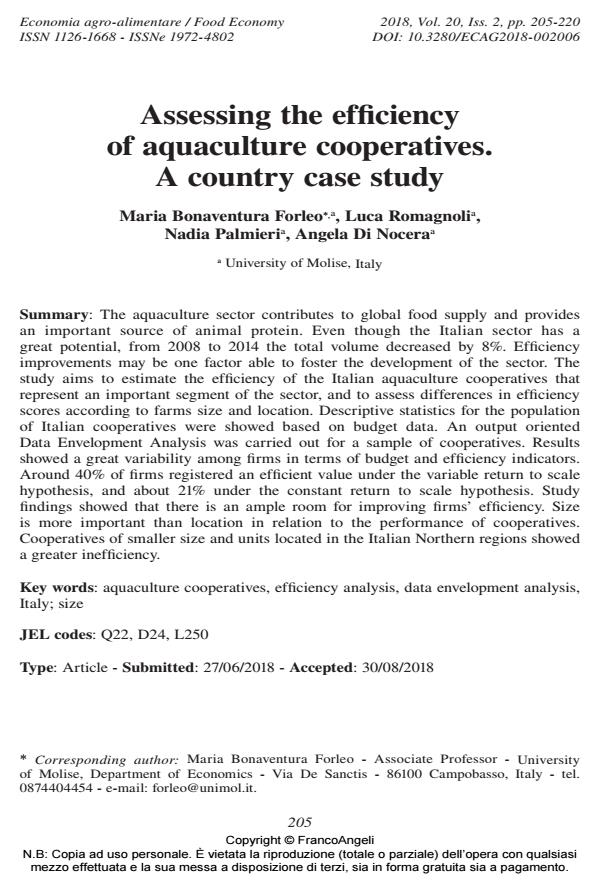Assessing the efficiency of aquaculture cooperatives. A country case study
Journal title ECONOMIA AGRO-ALIMENTARE
Author/s Maria Bonaventura Forleo, Luca Romagnoli, Nadia Palmieri, Angela Di Nocera
Publishing Year 2018 Issue 2018/2
Language English Pages 16 P. 205-220 File size 142 KB
DOI 10.3280/ECAG2018-002006
DOI is like a bar code for intellectual property: to have more infomation
click here
Below, you can see the article first page
If you want to buy this article in PDF format, you can do it, following the instructions to buy download credits

FrancoAngeli is member of Publishers International Linking Association, Inc (PILA), a not-for-profit association which run the CrossRef service enabling links to and from online scholarly content.
The aquaculture sector contributes to global food supply and provides an important source of animal protein. Even though the Italian sector has a great potential, from 2008 to 2014 the total volume decreased by 8%. Efficiency improvements may be one factor able to foster the development of the sector. The study aims to estimate the efficiency of the Italian aquaculture cooperatives that represent an important segment of the sector, and to assess differences in efficiency scores according to farms size and location. Descriptive statistics for the population of Italian cooperatives were showed based on budget data. An output oriented Data Envelopment Analysis was carried out for a sample of cooperatives. Results showed a great variability among firms in terms of budget and efficiency indicators. Around 40% of firms registered an efficient value under the variable return to scale hypothesis, and about 21% under the constant return to scale hypothesis. Study findings showed that there is an ample room for improving firms’ efficiency. Size is more important than location in relation to the performance of cooperatives. Cooperatives of smaller size and units located in the Italian Northern regions showed a greater inefficiency.
Keywords: Aquaculture cooperatives, efficiency analysis, data envelopment analysis, Italy; size
Jel codes: Q22, D24, L250
- Analyzing factors affecting the technical efficiency of small-scale seaweed farms using a two-stage double bootstrap DEA approach Marvin Louie G. Orbeta, Larry N. Digal, Ivi Jaquelyn T. Astronomo, Carol Q. Balgos, Shemaiah Gail P. Placencia, Melissa P. Loquias, Paolo Enrico Codog, in Journal of Applied Aquaculture /2023 pp.123
DOI: 10.1080/10454438.2021.1945520 - The Introduction of Insect Meal into Fish Diet: The First Economic Analysis on European Sea Bass Farming Brunella Arru, Roberto Furesi, Laura Gasco, Fabio Madau, Pietro Pulina, in Sustainability /2019 pp.1697
DOI: 10.3390/su11061697 - Assessing the efficiency of the Italian aquaculture firms Maria Bonaventura Forleo, Luca Romagnoli, Rosa Maria Fanelli, Nadia Palmieri, Angela Di Nocera, in Aquaculture Economics & Management /2019 pp.382
DOI: 10.1080/13657305.2019.1641569 - Efficiency data analysis in EU aquaculture production Ester Gutiérrez, Sebastián Lozano, Jordi Guillén, in Aquaculture 734962/2020 pp.734962
DOI: 10.1016/j.aquaculture.2020.734962 - Environmental Attributes of Wild versus Farmed Tuna: Beliefs, Knowledge and Purchasing Choices of Italian Consumers of Canned Tuna Maria B. Forleo, Nadia Palmieri, in Sustainability /2023 pp.7149
DOI: 10.3390/su15097149
Maria Bonaventura Forleo, Luca Romagnoli, Nadia Palmieri, Angela Di Nocera, Assessing the efficiency of aquaculture cooperatives. A country case study in "ECONOMIA AGRO-ALIMENTARE" 2/2018, pp 205-220, DOI: 10.3280/ECAG2018-002006